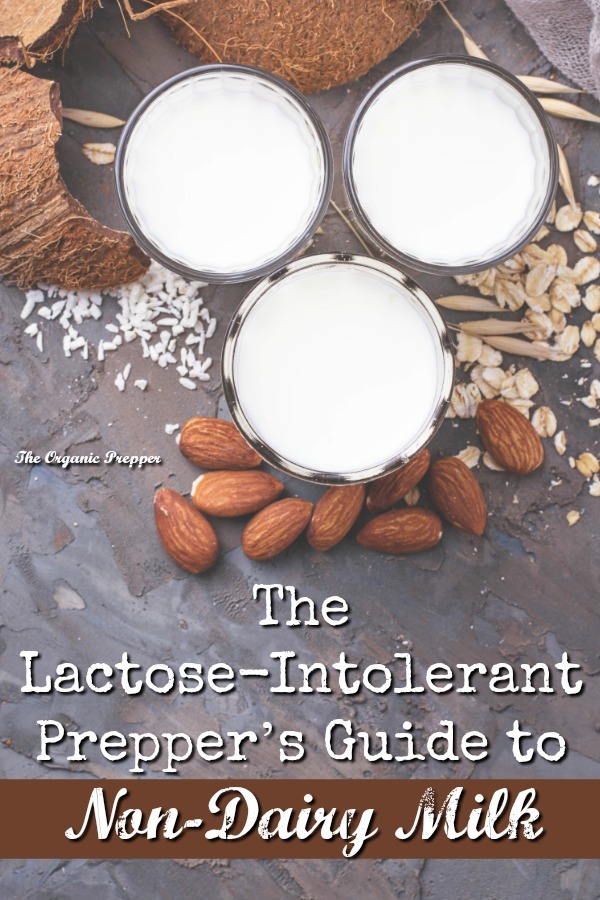
(Psst: The FTC wants me to remind you that this website contains affiliate links. That means if you make a purchase from a link you click on, I might receive a small commission. This does not increase the price you’ll pay for that item nor does it decrease the awesomeness of the item. ~ Daisy)
Author of Prepper’s Pantry and the online course Bloom Where You’re Planted
A lot of people are choosing non-dairy milk options because they are lactose intolerant. It seems to be ancestral, according to the US National Library of Medicine (1),
Approximately 65 percent of the human population has a reduced ability to digest lactose after infancy. Lactose intolerance in adulthood is most prevalent in people of East Asian descent, affecting more than 90 percent of adults in some of these communities. Lactose intolerance is also very common in people of West African, Arab, Jewish, Greek, and Italian descent.
The prevalence of lactose intolerance is lowest in populations with a long history of dependence on unfermented milk products as an important food source. For example, only about 5 percent of people of Northern European descent are lactose intolerant.
For someone who has difficulty digesting lactose, adding that kind of milk to their coffee or cereal is asking for a world of hurt. According to the Mayo Clinic (2), the symptoms of lactose intolerance usually appear 30 minutes to two hours after eating something that contains dairy. The symptoms include:
- Diarrhea
- Nausea, and sometimes, vomiting
- Abdominal cramps
- Bloating
- Gas
Definitely not something you want to add to an already unpleasant situation.
Non-dairy milk options for the prepper stockpile
First of all, if you’re in the midst of building your stockpile, check out our QuickStart Guide to Building a 3-Layer Food Storage Plan. It’s absolutely free and will get you on your way to be prepped FAST.
It’s very easy to get dairy-free options at the grocery store, but what about options for your stockpile? There are a few products you can stock up on, depending on the type of non-dairy milk you prefer. I always recommend that preppers stock up on items that are the closest to their day-to-day foods as possible, to prevent potential difficulties like an upset stomach or an unpalatable taste.
These are also good options for anyone who follows a vegan or paleo diet.
Coconut Milk:
Coconut milk is rich and creamy, making it a favorite for coffee drinkers. The coconut flavor is hardly noticeable.
So Coconut Milk: This is one of my daughter’s favorite options. You can purchase it by the case in shelf stable, 1-liter tetra packs. (Order here.)
Healthworks Organic Coconut Milk Powder: If space is an issue, you can get 75 servings of coconut milk in a handy, 1-pound bag of powder. (Order here.)
Native Forest Organic Coconut Cream (canned): This product can be used when a thicker consistency is needed – you can even make whipped cream from it. (Order here.)
Cashew Milk
This is one of the creamier-textured non-dairy milks, making it excellent for coffee. It adds a very slight nutty flavor.
So Delicious Cashew Milk: This is a 6-pack of 1-liter tetra packs. (Order here)
Almond Milk
Keep in mind that almond milk can separate when it’s heated up. For that reason, some people don’t care for it in coffee. You can also make your own. (See the DIY below.)
Silk Unsweetened Almond Milk: This is a 6-pack of one-quart tetras. (Order here.)
Pacific Foods Organic Almond Milk: If you buy it in this 12-pack, it costs only 2 cents more per ounce to purchase the organic version. (Order here.)
Oat Milk
Oat milk is one of the best-priced options for shelf-stable milks, and it is high in iron.
Pacific Foods Organic Oat Milk: This is a 12-pack of 32-ounce boxes. (Order here.)
Rice Milk
Rice milk has a more watery consistency than cashew and coconut milks. You can also make your own. (See the DIY below.)
Organic Rice Dream: This is one of the least expensive non-dairy options – and it’s organic. (Order here.)
Hemp Milk
Like rice milk, this is a thinner consistency. It is very nutrient-dense, making it a good choice. Some people (me – I’m “some people”) don’t care for the earthy flavor of hemp milk.
Pacific Foods Hemp Non-Dairy Milk: This is a 12-pack of 32-ounce tetras. It is lightly sweetened with brown-rice syrup. This brand is carrageenan-free. (Order here.)
Nutiva Hemp Protein Powder: This is not really a milk substitute, but could be added to water or coffee for a huge boost of protein. Several flavors (including unflavored) are available. (Order here.)
Soy Milk
I never purchase soy products due to associated health concerns (3) and the fact that nearly all of them are GMO. However, if you are a fan of soy milk (it reportedly blends very smoothly with hot beverages) here are some shelf-stable options. Look for organic options only if you want to avoid GMOs. “Natural” on the label is completely meaningless.
Silk Organic Soymilk: This is a very reasonably priced organic option. Comes in a package of six 32-ounce cartons. (Order here.)
NOW Foods Organic Soy Milk Powder: This is a much more expensive option than the other organic products listed in this article, but it was the best quality powdered soy product I could find. (Order here.)
Or…you can make your own alternative milks
All you need to do is stock up on rice or almonds. And let’s face it, what prepper doesn’t have rice?
These recipes are from my book, Prepper’s Pantry.
How to make rice milk
Ingredients:
- 1 cup of cooked rice (brown or white)
- 4 cups of water
- 1 tsp of vanilla (optional)
Directions:
1. Put all of the ingredients into a blender.
2. Process until smooth.
3. For the best flavor, keep cold. Shake well before using.
Because of the potential toxicity of a heavy consumption of rice (remember how we talked about arsenic?), for long-term usage, you may wish to go with almond milk, which is slightly more involved.
How to make almond milk
Almond milk has a couple of extra steps – soaking the almonds before processing them in the blender, then straining the finished product through cheesecloth or a flour sack towel.
Ingredients:
- 1 cup of almonds
- 4 cups of water (plus more for soaking)
Directions:
1. Place one cup of almonds in a glass dish. Cover them with water and allow them to soak overnight. You can cover the bowl with a tea towel to keep any contaminants out. Soaking will soften the nuts and make the processing easier and more thorough.
2. Drain the soaking water from the almonds, then place them in your blender with 4 cups of water.
3. Process until smooth.
4. Use a flour sack towel over a clean container to strain the contents of the blender. Don’t throw out the almond sludge that you strain out of the milk! This can be dried and added to baked goods and recipes.
5. Like rice milk, almond milk will taste better when cold. Shake well before serving.
Easy peasy!
What is your solution?
If you avoid dairy for whatever reason (lifestyle choices or lactose intolerance), what is your plan for non-dairy milk in your stockpile? Will you simply do without, or are you putting something back? Do you have any tips for other non-dairy-consuming preppers?
Let’s talk about it in the comments section.
Resources:
Healthworks Organic Coconut Milk Powder
Native Forest Organic Coconut Cream (canned)
Pacific Foods Organic Almond Milk
Pacific Foods Organic Oat Milk
Pacific Foods Hemp Non-Dairy Milk
NOW Foods Organic Soy Milk Powder
References
(1) US Library of National Medicine
(2) Mayo Clinic
(3) 170 Scientific Studies Confirm the Dangers of Soy
About Daisy
Daisy Luther is a coffee-swigging, adventure-seeking, globe-trotting blogger. She is the founder and publisher of three websites. 1) The Organic Prepper, which is about current events, preparedness, self-reliance, and the pursuit of liberty; 2) The Frugalite, a website with thrifty tips and solutions to help people get a handle on their personal finances without feeling deprived; and 3) PreppersDailyNews.com, an aggregate site where you can find links to all the most important news for those who wish to be prepared. Her work is widely republished across alternative media and she has appeared in many interviews.
Daisy is the best-selling author of 5 traditionally published books, 12 self-published books, and runs a small digital publishing company with PDF guides, printables, and courses at SelfRelianceand Survival.com You can find her on Facebook, Pinterest, Gab, MeWe, Parler, Instagram, and Twitter.

